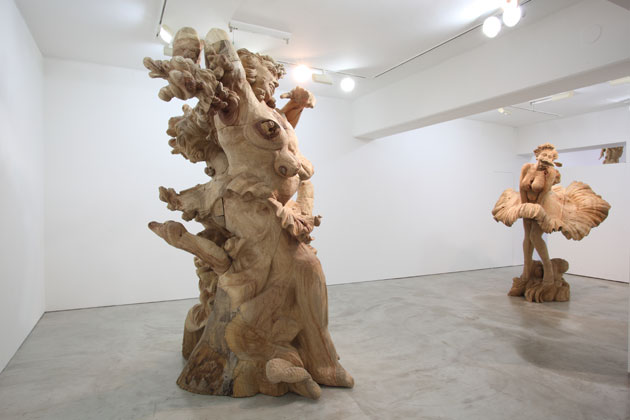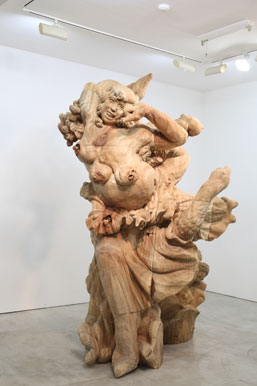If fantasies were to have forms
The elevator doors open, and you are greeted by a large scale wooden sculpture. In your first quick glance, the animal-like sculpture looks almost Baroque with its dramatic pose and minute details of flaring skirts. By the time you look closer and start to process the subject matter behind this work, you probably would already have a smile on your face. Right in front of you, greeting gallery visitors with its stunning presence, is a giant Leda with the face of Betty Page. Welcome to Osamu Mori’s “Can’t Help Falling in Love” exhibition.
Recently graduated from Tokyo University of the Arts in 2009 with a Master’s Degree in Sculpture, Mori holds his first solo exhibition at YAMAMOTO GENDAI with four large-scale masterpieces: ‘Pink Party -– Cancan’ (2010), ‘Love Me Tender — Leda and the Swan’ (2010), ‘Much Ado About Love — Kappa’ (2009) and ‘Absolute Domain — Dragon’ (2008). The exhibition is separated into three sections of brightly lit rooms with equally bright, white walls: the entrance area where we see ‘Pink Party –- Cancan’ welcoming us in, the large main exhibition space filled up with vigor from ‘Love Me Tender — Leda and the Swan’ and ‘Much Ado About Love — Kappa’. Slightly cut off from the rest is the meeting room with sofas where visitors can sit and fully appreciate Mori’s amazing attention to details in ‘Absolute Domain — Dragon’.

All of Mori’s wooden sculptures contain one very distinct characteristic apart from ‘Absolute Domain — Dragon’: they are all mash-ups of images associated with male fantasies. A large scale bunny girl with one breast is dancing the Cancan in ‘Pink Party -– Cancan’. The bird-like Betty Page/Leda with three breasts pregnant with Zeus’ child is being wooed by the Swan/Zeus in ‘Love Me Tender — Leda and the Swan’. A mixture of a Kappa with three breasts and Marilyn Monroe in her iconic flaring skirts pose is ‘Much Ado About Love –- Kappa’. References to sex icons, images that sexualize female and Greek mythology are predominant in these sculptures. However, instead of beautifying the subject matter, Mori chooses to de-beautify them by mixing them all together, leaving a rather cheeky comment on the absurdity of fantasies when they are visible in the real world.
 Mori also pays great attention to the experimental aspects of the dramatic pose and the spontaneity of the process. The sculptures are posed in snapshot-like positions as though he caught them in their movements. Another common formal qualities in his sculptures are also the mixture of animal-like features with the two sex icons’ images. The resulting effect is the intense contrast of their inhumane appearances and their dramatic facial expression similar to that of pin up girls, which may constitute Mori’s commentary on how society seems to view pin up girls as something unreal or even as organisms from a total different species.
Mori also pays great attention to the experimental aspects of the dramatic pose and the spontaneity of the process. The sculptures are posed in snapshot-like positions as though he caught them in their movements. Another common formal qualities in his sculptures are also the mixture of animal-like features with the two sex icons’ images. The resulting effect is the intense contrast of their inhumane appearances and their dramatic facial expression similar to that of pin up girls, which may constitute Mori’s commentary on how society seems to view pin up girls as something unreal or even as organisms from a total different species.
The technical aspects of the sculptures are also considerably as innovative as the ideas behind the works. Mori gives much attention to his unpremeditated methods and the nature of materials. He experiments with the overall compositions of each work through his sculpting process, rather than through pencil drafts. He also takes great notice of the sculptural material’s nature through the use of half-dried lumber instead of dried ones, allowing warps and cracks to be a part of the works and even to function as specific body parts. His sculptural techniques are best observed in ‘Absolute Domain — Dragon’, which is exhibited in the meeting room, allowing visitors to take their time to appreciate the decorative details as long as they please.
Mori excels in controlling and making use of the spontaneity in the process of art-making, both to create drama and minute details without being excessively decorative. His approach in representing male fantasies is also both socially critical and absurdly entertaining to observe at the same time. Furthermore, because none of the works are actually labeled in this exhibition, visitors also have the chance relate the images to that of their own fantasies. Mori has indeed achieved a comical, yet thought-provoking first solo exhibition, and shows promising potential as a young rising artist.
Cheri Pitchapa Supavatanakul
Cheri Pitchapa Supavatanakul


